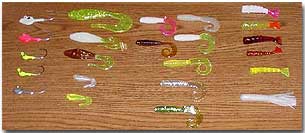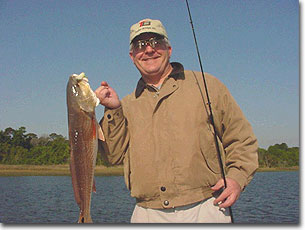In Search for the Perfect Soft Plastic
In Search for the Perfect Soft Plastic
By Jim Hammond
How many of you, are like me? Tackle tray after tackle tray full of what we had hoped to be the answer to soft plastics.
Here is another style of lure that every tackle company makes and makes in so many styles, shapes, colors, scents and sizes that the average fisherperson is so confused that we end up buying some of all. We get home, break out another pack of Plano Tackle trays, sort out our new lures by shape or size or maybe scented and un-scented, place them in the boat or in the tackle bag awaiting our next fishing trip.
On the next trip we cannot wait to get to a spot that looks fishy enough to try our new soft plastics. We break out our newly packed box or boxes or these jelly like slimy lures and try to make sense of all of the colors, as we are also trying to decide which color lead head to tie to our line that might be worthy enough for our new lures. After a minute or two we have made the decision on lure and lead head. Now we are ready to try our new fishing lure or are we. As we are tying the lead head to the line and slipping the hook into the soft plastic, we are all thinking the same thing, is this the correct one. Is this the color that the fish want, is it the correct size and shape, is the lead head the correct color. What have we done? We know how to catch fish on live bait and MirrOlures, what are we doing adding another variable into this vast science of how to catch fish.
 Here is a picture of some of the baits that are a must in my boat. The lead heads are from 1/4 ounce to one ounce. The shad bodies are Mr. Wiffle. The grubs and shrimp are Sea Striker. All of these work in the waters of Northeast Florida and probably all over the world. Here is a picture of some of the baits that are a must in my boat. The lead heads are from 1/4 ounce to one ounce. The shad bodies are Mr. Wiffle. The grubs and shrimp are Sea Striker. All of these work in the waters of Northeast Florida and probably all over the world.
We go ahead and throw the soft plastic, working it like we think the fish would like to see it. A couple of cast without the hint of a strike and we are second guessing ourselves. Should I change colors, maybe squirt some smell good on it, is the lead head the right color. Look what we have done. Fishing is supposed to be fun. We have taken fun and turned it into a guessing game.
Here is how I have tried to use soft plastics in a way that is both fun and productive (most of the time). For me there are about six basic colors and most of the time two or three that are used to consistently catch fish. Lead head jigs can be painted or unpainted. If I use a painted one, I like red, chartreuse or white. Lead heads can also be a thing to cause much concern when deciding which one to tie on. I like a lead head that has a VERY sharp, stout hook, like the Jaw Jacker jig head. If I am going to troll, I want a lead head the is shaped in a way that it will allow the bait to dive. This lead head is shaped like a tear drop with the pointy end in the front. This allows the lead head to act like a planner and dive when pulled on from the hook eye. When I am tossing a lead head around the edges I like one the is shaped like a sled in the front, slopped upward. This allows you to pull the lead head through the oysters with getting hung up too bad.
Now that we have a better understanding of lead heads, lets touch on soft plastics. Think of all of the colors that you either have purchased or seen and narrow them down to about five or six colors. Color is a big deal when it comes to soft plastics. Look in any professional fisher persons bag and you will see about five or six colors that he/she uses all of the time. The others are just for show or maybe for that rare occasion when the fish just want something that looks like it came from around a punk rockers ear ring.
Colors will sometimes change from one area to the next but I will bet that I can take the six colors that I fish and catch fish just about anywhere.
The colors that you will find tied on to my line most of the time are white with a chartreuse tail, chartreuse, root beer with a chartreuse tail, white, white with a red tail and motor oil. And the one that is my day in and day out favorite is white with a chartreuse tail. Now these are the baits that work well for me. Some of you might have colors similar or completely different than these that perform well for you. These are the colors that I have consistently caught fish on, so my CONFIDENCE level is high with these colors. Remember, I have talked before about confidence and how it will help you to fish a lure harder and longer than you would a lure that you have no confidence.
Now for sizes:
 Here is a happy angler with a nice red which ate his Mr. Wiffle shad body soft plastic. Here is a happy angler with a nice red which ate his Mr. Wiffle shad body soft plastic.
Most of the year, the fish that I am after, reds, trout, flounder, tarpon, jacks and ladyfish, will all eat a mullet about four inches long, so that is the size that I generally use. There are times of the year and places that I will throw a two inch soft plastic and times that I will throw a six inch soft plastic, but most of the time a four inch bait. I am not after that one or two big fish that a larger bait might attract. I am after numbers most of the time and to accomplish this you need to throw something that will fit in the mouth of smaller fish. Now, I have had plenty of ten plus pound reds and six plus pound trout on the four inch lure and the largest trout that have ever caught (12 plus pounds) came on a shrimp that was about three inches long. So big fish will eat small baits.
Last week James Howard and I were filming a show and we were throwing four inch long white body, chartreuse tail Mr. Wiffle shad bodies and each of us had big trout come up and inhale these baits. We caught over 30 fish in about 1 1/2 hours, all from the Mr. Wiffle 4 inch shad body white with a chartreuse tail.
This past weekend my we had several nice reds and flounder on the same bait.
Working the bait:
Most of the soft plastics have no scent so you have to work the bait to draw an impulse strike. What I mean by this, is, I like to toss it out and start winding and twitching to make the bait look like it is wounded. I like to bring my rod tip up with a brisk motion to make the bait move about a foot. Then let the bait fall while I am reeling up the slack line. If this does not work for you then point the rod tip at the waters surface and pull back on the tip about a foot or so and wind up the slack while the bait falls to the bottom. You cannot let this type of unscented bait just sit on the bottom because it gives the fish too much time to look at it and you lose the impulse strike.
You can scale down to a 1/8 ounce lead head if you do not have to make a long cast or in the winter and work the bait a little slower to obtain the same results.
|
